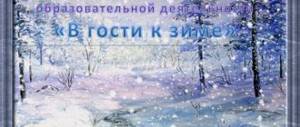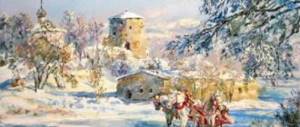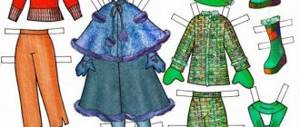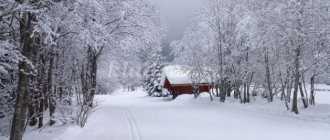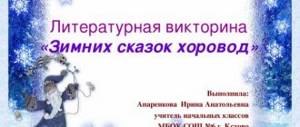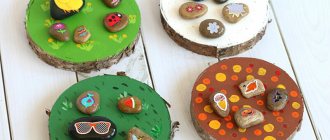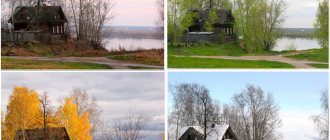Children about snow
Winter is, first of all, snow... Seeing stunningly beautiful snowflakes, a child has a lot of questions about what it is and how it turns out. There is a very easy answer to this case. You and I already know everything about the water cycle in nature, but this needs to be explained to the child...
Water gradually evaporates from puddles, seas, lakes, rivers and oceans and rises upward, where under the influence of temperature it cools, groups and turns back into water. If the temperature is very low, it is very cold outside, then the droplets freeze and fall to the ground in the form of snowflakes. As the weather warms, these white magical snow crystals melt, evaporate, rise to the top, and the water cycle in nature starts again. Despite the fact that snow is frozen water, it is better not to eat it, as it tends to collect dust and dirt, especially in a modern metropolis.
Speaking about snow, I can’t help but remember the amazing “Book about Snowflakes” by Olga Dvornyakova. It provides comprehensive answers to all children's questions about snow.
Animals in winter
Animals know how to adapt to winter, and many, just like humans, begin to prepare for it in the fall. In case of frost, animals have a fluffy, warm coat of wool and fur. The main problem is obtaining food during this period. Some animals solve this problem by simply hibernating until spring. Such animals include the bear and badger. Although the badger periodically wakes up to refresh itself with its supplies.
Some animals store food for the entire winter. For example, a chipmunk can prepare about 10 kg of nuts and grains of bread for the winter. And the squirrel hides its supplies everywhere, but cannot always find them, then it feeds on seeds from pine and spruce cones. The field mouse also stores itself for the winter in its burrow. Animals such as hares, wolves, foxes and moose can easily get food for themselves in winter thanks to their sense of smell, vision and agility.
Fish feel calm underwater in winter, because there is enough food there. Their main problem is a lack of air when the reservoir is covered with ice, so you can often see small holes, this is how people make sure that the fish do not die out in the reservoir.
During blizzards and snowfalls, as well as in severe frost, when the trees are covered with frost, it is difficult for birds to get insects from under the bark. After several hours of starvation, some birds may die. Therefore, it is very important to feed birds in winter. Set up feeders in gardens and parks. Birds fly to feeders and peck not only the seeds, grains and crumbs you leave, but also insect pests on trees and shrubs located next to the feeder. This is how birds bring great benefits. If birds constantly find food in the feeders, then they will fly to them in the summer, which means they will clean the trees of pests all year round.
Plants in winter
Just like animals, plants prepare for cold weather in the fall. Someone throws their seeds into the ground. Almost all plants shed their leaves by winter, except coniferous trees and fall into winter sleep. Buds ripen on their branches until spring.
Plant growth does not stop, but only slows down slightly. Snow cover serves as an excellent blanket; the roots of bushes and trees do not freeze, they are reliably protected.
Stage 2 – main (practical):
- Phenological observations.
- Excursion on the topic: “On a visit to winter.”
- Didactic games: “Find mistakes”, “Who does what in winter”, “Find the trail”, “Find the same snowflake”, “Scouts”.
- Outdoor games: “Two Frosts”, “Blizzard”, “Whose pair is the fastest”.
About winter sports and entertainment
Many children have a particularly positive attitude towards the winter season; most of them simply adore winter, because that’s when they can play snowballs, sledding and engage in winter sports. The most popular winter sports include: skiing and snowboarding, hockey, figure skating and speed skating, and luge.
All sports can be divided into two categories: on ice and on snow. Competitions can be for speed, distance or even technique. All of them are very useful for a young growing organism. This includes hardening, physical activity and incredible emotions. And if everyone should know about hockey and skiing, not everyone knows what luge, snowboarding or biathlon are.
- Biathlon is an exciting ski race combined with target shooting
- Snowboarding is riding on one board down a snowy slope.
- Luge sports include skeleton and bobsled - this is, as a rule, a downhill race on sleds of various shapes.
- Conversations: “Why I like winter”, “How do animals spend the winter in the forest?”, “Help the birds”, “Caution! Winter injuries”, “How to take care of your health in winter”.
- Examination of reproductions of paintings by Russian artists on the theme “Winter”.
Project in the senior group: “Hello, winter-winter!”
Project in the senior group on the topic “Hello, winter - winter!”
Project type
: cognitive-research, creative-informational.
Implementation deadlines:
December, January, February 2018-2019
Project participants:
children, teachers, parents
.Target
: give knowledge about living and inanimate nature in winter. To cultivate a love for the nature of one’s native land and a caring attitude towards it. Creating conditions for the development of children’s cognitive and creative abilities in the process of developing the joint project “Hello, Zimushka-winter!”
Tasks:
- Expand ideas about winter natural phenomena through educational and research activities.
- Introduce the phenomena of inanimate nature (frost, strong winds, it is snowing, blizzards are blowing, frozen water bodies), the properties of snow (white, crispy, crumbly, cold, fluffy, sticky).
- Clarify and expand on the lifestyle of wild animals in winter (hare, fox, wolf, bear and squirrel). Expand your understanding of the diversity of birds (bullfinches, tits, sparrows), methods of obtaining food, and adaptation to winter living conditions.
- Create conditions for identifying the properties and qualities of snow and ice. Introduce the process of turning water into ice, ice and snow into water.
- Learn to establish connections between living and inanimate nature (weather - state of water, snow; season - state of plants), analyze, draw conclusions.
- To develop curiosity, cognitive interests, attention, memory, speech, observation, desire to care for animals and plants, and environmental awareness of preschoolers.
- Evoke more positive emotions, feelings of admiration for nature.
- Create a desire to help our winged friends during the winter lack of food.
- Develop communication skills, memory, attention, creativity.
Relevance of the project:
Nature is an integral part of the life surrounding a child. The diversity and beauty of natural phenomena, plants and animals attract attention, awaken feelings, provide a vast field of activity for the mind, manifestation of emotions and active actions. Winter for our children should be an unforgettable time of year, the expectation is that every winter day in kindergarten has a lot of new and interesting things in store for preschoolers. We must try to ensure that children enjoy winter.
Expected Result:
- children gain experience of productive interaction with each other, the ability to listen to a friend
- increased cognitive activity
- mastering the necessary knowledge about winter
- the formation of a sustainable interest in observing natural phenomena.
. Project implementation forms:
- Classes.
- Conversations.
- Observations.
- Leisure activities.
- Game activity.
- Research activities.
- Productive activities of children.
- Reading fiction.
Stage I – preparatory
- Creating the necessary conditions for the implementation of the project.
- Development and accumulation of teaching materials.
- Creation of a developmental environment.
- Selection of fiction on the topic.
- Development of events.
Stage II – basic (practical):
Didactic games:
- “Find mistakes” (which doesn’t happen in winter)
- "Who does what in winter"
- "Find the trail"
- “Find the same snowflake”
- “Scouts” (notice what has changed in nature)
- “Guess what they look like?” (patterns on the windows)
- "Seasons"
- "Find out by description"
- "Winter supplies"
- “Find and feed wintering birds”
- "When it happens"
- "What's first, what's next."
Word games:
“Which one, which one, which one?”, “From what - which one” (snow slide, snowy, etc.), “Say the other way around.”
Role-playing games:
“We have guests”, “We’ll arrange a concert for the Christmas tree”, “Farewell to the Christmas tree until next year”
Board and printed games:
"Seasons"
Outdoor games:
“Two Frosts”, “Red Nose Frost”, “Little White Bunny Sitting”, “Homeless Hare”, “Snowballs”, “Red Nose Frost”, “Snowflakes and the Wind”, “Birds in Nests”.
Game exercises:
“Snowflakes are spinning”, “Catch a snowflake”, “Through the snow labyrinth”. Sliding along icy paths.
Getting to know your surroundings
: “Winter is full of silver”, “The sorceress winter is coming”, “Winter hut of animals”.
Design and manual labor from natural materials:
“Winter meadow” (modeling from paper and cotton wool), “Winter hut of animals” (origami).
Conversations:
- "How do birds live in winter"
- "Meeting Winter"
- "Winter in our region"
- "Why I like winter."
- “How animals spend the winter in the forest.”
- “How Do Pets Winter”
- “How a person helps animals in the forest in winter.”
- “Why does the snow creak?”
- "Help the birds."
- “Why does it snow in winter?”
- "Carefully! Winter injuries"
- “How to take care of your health in winter.”
- "Where does the snow come from"
Observations:
- changes in winter nature during walks (sun, sky, wind force, snow)
- for the beauty and richness of winter colors
- birdwatching
- behind the trees growing on the territory of the kindergarten
Target walks:
“Scouts” (notice what has changed in nature), “Guess what they look like?” (patterns on the windows). Winter fun outside. Ecological trail preschool educational institution. To the winter park.
Experimentation:
conducting experiments and experiments with snow.
Reading
fiction:
- N. Sladkov “The Trial of December”
- V. Odoevsky “Moroz Ivanovich”
- S. Ivanov “What kind of snow happens”
- E. Trutneva “First Snow”
- K. Balmont “Snowflake”
- G. Snegirev “About Birds”
- N Sladkov “Spruce porridge”
- V. Zotov “Klest”, “About Birds”
- V. Bianchi “Who flew to the feeding trough?” , “Titmouse Calendar”, “Young Crow”
- S. Marshak “Twelve months”
- Brother Grimm "Mistress Blizzard"
- Riddles about winter phenomena in nature
- Proverbs and sayings about winter.
Children's storytelling on topics:
- "Signs of Winter"
- "Who needs winter"
- “If there was no snow in winter...”
- Looking at pictures about winter and writing descriptive stories based on them
Direct educational activities.
Speech development
: "Winter forest"; acquaintance with the surrounding world: “Winter in the forest”; integrated lesson: “Winter-winter!”
Examination of illustrations and paintings from the series “Winter Fun”, “Winter Holidays”, “Animals in Winter”, “Artists about Winter”. Examination of plot paintings (“Winter Forest”, “Sledding”, “Winter Landscape”, “Sasha and the Snowman”). Compiling descriptive stories based on paintings. Learning poems about winter. Using proverbs, sayings about winter, explaining their meaning.
Labor activity:
- Preparing bird food
- Feeding the birds.
- Clearing paths of snow while walking.
- With the help of the teacher, sprinkle the paths with sand.
- Together with the teacher, clear the snow from the play area.
- Clearing paths from snow.
- Construction made of snow.
Creative workshop.
- Cutting out snowflakes.
- Design of the “Winter” layout
- Modeling snowflakes.
- Vernissage: “Winter-Winter”
- Drawing: “Trees in frost.”
- Drawing: "Winter Night"
- Drawing "Snowflakes - ballerinas"
Application:
“Snowy House”, “Jolly Snowman”, “Santa Claus’s Birthday”.
Modeling:
“Winter Trees”, “How We Play in Winter”, “Girl in a Long Fur Coat”.
Listening to music:
"Winter's Tale"; “If only there were no winter..”; "Merry Winter"; “Once in a frosty winter”; “Waltz of Snow Flakes” from the ballet “The Nutcracker”, music. P.I. Tchaikovsky music, learning songs.
Breathing exercises:
"Blow on a snowflake"
Working with parents:
- “Super Canteen for Birds” - making bird feeders.
- Design of the traveling folder “Walking in Winter”.
- Registration of information in the parent's corner: “Winter injuries.”
- Consultation for parents “Prevention of colds”
- Consultation for parents “How to make a walk enjoyable and useful”
- Consultation for parents “Child’s clothes for a winter walk”
- Making a folder - moving on the topic “Six misconceptions of parents about winter weather”
- Family New Year crafts competition,
- Organization of exhibitions of children's works
Results of project activities:
- Children have an idea about winter, its signs, and have acquired new cognitive experiences;
- got acquainted with the works of poets, writers and artists on the theme of winter;
- mastered an expanded vocabulary;
- have an idea of the nature of their native land;
- are familiar with the rules of safe behavior in nature;
- Recommendations for parents have been developed.
Stage III – final
.
New Year's crafts competition.
New Year's party.
Creative work with children.
Poetry competition about winter.
Conclusion
During the implementation of the project, our children expanded their understanding of winter (weather conditions, typical precipitation, the characteristics of the life of wild animals and birds in winter), they learned to understand the beauty of nature, expressed in words, as well as with the help of an artist’s brush. We learned to empathize with “our smaller brothers”, became more sensitive and attentive to wintering birds and animals, the children became more developed in their cognitive activity, their creative abilities, imagination, logical thinking, and the ability to notice changes in nature.
Winter in painting
Winter is a very bright and beautiful time of year. Most artists have always strived to capture these incredible images in the form of their paintings. Among the most famous artists is V. Polenov with his painting “Early Snow”,
I. Levitan “Winter in the Forest”, I. E. Grabar “February Azure”, I. I. Shishkin “Winter” and many others.
- Reading fiction:
Senior group. Senior preschool age. Children 5-6 years old
Project “Hello, guest winter!” Senior group Type of project : educational-research, creative-informational, social. Implementation timeframe: Short-term: 3 weeks. Project participants : Children, teachers, assistant teacher of the senior group, parents of students, music director. Project idea :…
Planning the educational activities of a teacher with children of the senior speech group within the framework of the project “Hello, guest Winter” State budgetary preschool educational institution kindergarten No. 49 of the Combined type of the Kalininsky district of St. Petersburg Planning of the educational activities of a teacher with children of the senior speech group on cognitive-speech development within the framework of the project Topic :...
